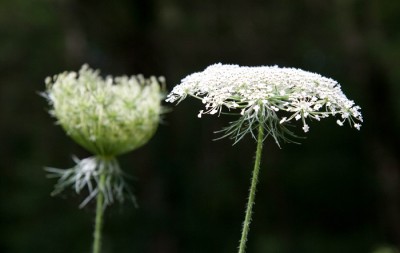Early summer is a fine time to gather herbs for fresh use as well as for preserving them. Summer is also a great time to take note of spring herbs [2] which you may have missed. Write down their location now so that next year you will be on the lookout for them.
Take out your herb identification guide. During early summer, you are likely to identify more herbs now than you could at other times of the year. Seeing plants with berries, leaves and flowers in their natural habitat is a more accurate and simpler method than trying to identify a root or the bark of a bare tree in the fall or winter.
Early summer is a great time of the year to gather flowers and young leaves while they are in their prime and before they get eaten by bugs. Gather your herbs in the late morning whenever possible. Give the morning dew time to dry off and harvest the herbs while their essential oil content is at its peak.
Preserving Summer Herbs
I prefer to dry herbs on a screen. I do use a dehydrator and hang herbs, too. Usually, I keep herbs whole or in large pieces after drying because they keep longer. Herbs dry quickly in summer. Dry them in a well ventilated, dark place. The humidity, type of plant and drying method influences how long it takes to dry summer herbs. Leaves and flowers should be crisp when packaged. Store them in a dark place at room temperature or below.
Even if you are convinced that you will remember what plant you preserved, label it carefully. Document where you gathered it, the date and the name of the plant. It is best to write down the scientific name as well as the common one. If you make tinctures, syrups or herbal blends, list information about each ingredient. Document the dilution of alcohol, glycerin or other menstruum used if you make liquid preparations.
The Hidden Secrets Of Making Herbal Medicines…Right At Your Fingertips! [3]
Some berries, such as elderberries, can be easily dried. It is often easier to dry them with a dehydrator or make syrups and vinaigrettes from berries.
Early summer is usually not the time for gathering seeds, bark or roots. However, if a summer storm knocks down limbs from a tree which has herbal uses, be sure to harvest some of the bark.
Early Summer Herbs for Harvesting
Early summer is a fantastic time to harvest basil, dill, chives and a wide array of garden herbs. Make some pesto and freeze it in ice cube trays so that you will have inexpensive, fresh herbal flavors available all winter long. Make lemon verbena or mint teas to cool yourself off on hot summer afternoons.
Here are three more you should try and find:
1. Yarrow: a virtual medicine chest

Yarrow
Yarrow is abundant in gardens and in the wild. Yarrow also is known by its scientific name, “Achillea millifolium.” The entire above the ground, aerial section of the plant is useful medicinally. The flowers also dry nicely and can be used for flower arrangements. Yarrow is my favorite herb to use as a first aid agent. It stops bleeding and fights infection. It may be used internally or topically on wounds. Yarrow relieves fever and lowers blood pressure. The plant dries well, but it is most potent when used fresh. I like to prepare it as a fresh tincture for internal use.
2. Lady’s Mantle: not just for ladies
Lady’s Mantle – Alchemilla vulgaris – is a beautiful plant. The dew was traditionally gathered from the showy leaves and used to make preparations which were said to make women beautiful.
New “Survival Herb Bank” Gives You Access to God’s Amazing Medicine Chest [4]
Today, herbalists use lady’s mantle to reduce menstrual pain and heavy bleeding during menses. It helps to normalize the menstrual cycle. Lady’s mantle has astringent qualities so it also is useful as a gargle for sore throats. Lady’s mantle tea is consumed three times daily for menstrual difficulties. Even though the leaves are used, lady’s mantle should be simmered gently for a few minutes before infusing off of the stove for 20 minutes so that the healing compounds can be extracted more thoroughly.
3. Queen Anne’s Lace: beauty and medicine in one plant
Wild carrot, commonly known as Queen Anne’s lace, and botanically called Daucus carota, is a showy summer plant with decorative and healing uses. Press the blossoms in a flower press or old telephone book and have snowflake like flowers for making winter decorations. If you gather the flowers for decorative purposes, select ones that are just a day or so away from being in full bloom. They are the most decorative and have the most staying power.
Make a tea from the seeds and plant tops and drink it as a remedy for kidney stones and urinary tract infections. It helps to settle upset stomachs and relieves gassiness, too.
Healing with Summer Herbs
This is a wonderful time of year to reap the full healing power of herbs. Get some exercise, enjoy the sunshine and notice the beauty of the plants while you gently and carefully harvest early summer herbs for year-round use.
What herbs would you add to this list? Share your suggestions in the section below:
